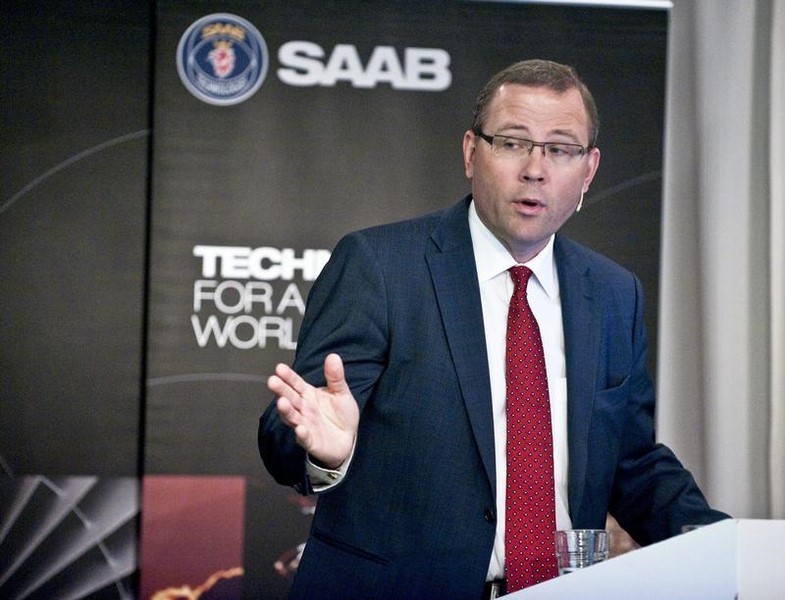By Tim Hepher and Robin Emmott
LINKOPING, Sweden/BRUSSELS (Reuters) - Pressure from the United States on NATO allies to increase their defense spending could strain the capacity of the arms industry to keep up with demand, the head of Swedish fighter jet and submarine builder Saab said.
While many analysts believe European arms makers have plenty of spare capacity, Saab Chief Executive Hakan Buskhe pointed to tensions over Russia's actions in Ukraine and said alliance members would have to respond to the U.S. demands.
Military spending stagnated for so long after the Cold War that the budgets of many states are well below a NATO target of 2 percent of gross domestic product, putting them at odds with Washington, Buskhe noted.
"I believe that due to the rather tense situation in many areas we will see a big increase in spending in Europe," he told reporters as Saab prepared to unveil a more powerful version of its Gripen fighter on Wednesday.
"That will lead to a new situation, a new normal," he said at the Gripen plant in the southern Swedish city of Linkoping. "You can really question whether the defense industry can deliver such a big volume on short notice, having had a long period of decreasing capabilities."
Saab largely supplies the militaries of Sweden and developing countries such as Brazil, but NATO members are also among its customers.
According to NATO data, four out of the 28 alliance countries apart from the United States met the 2 percent threshold last year: Britain and Greece plus eastern European members Estonia and Poland.
Former Soviet bloc countries fearful of Russia are proportionately big spenders while other allies such as Italy are still cutting to reduce the strain on their budgets following the euro zone crisis.
By contrast, the United States is by far the biggest contributor, spending 3.6 percent of its national output on defense. There the issue has surfaced in campaigning for the presidential election later this year.
Republican candidate Donald Trump has said the North Atlantic Treaty Organisation costs the United States too much and that laggardly members should "pay up or get out".
Democratic candidate Hillary Clinton has accused Trump of putting the alliance at risk, but has also urged European allies to absorb a bigger share of NATO's costs.
"If Trump or Hillary stick to what they are saying ... then we will have huge demand on the whole supply chain," Buskhe said, adding that the defense industry will have to shorten long lead times for building new products.
Saab says its new Gripen E fighter has been designed to shorten the time it takes to add upgrades, while sticking to an 11 billion Swedish crown ($1.3 billion) development budget.
NATO allies agreed at a 2014 summit to hold spending at 2 percent of GDP or fill any budget shortfalls within a decade, and the issue will resurface when alliance leaders meet again this year in Poland.
"We've seen since the NATO summit in Wales that the defense cuts have pretty much halted across the alliance. Many allies have committed to increasing spending to get to, or towards, 2 percent," said one NATO diplomat.
"But clearly there is more work to do and defense spending will be a big priority at the Warsaw summit in July."
DRAGGED DOWN BY ITALY
NATO's defense spending as a share of economic output fell 1.5 percent in 2015, the sixth straight year of cuts, dragged down by a 12 percent decrease in Italy. The United States accounts for almost three-quarters of NATO military spending.
Still, 16 allies spent more on defense in real terms in 2015 and there was an increase in spending on new equipment. Poland's decision to raise spending by almost a quarter, as well as a strong showing in the Baltic nations that want more NATO troops in the region, helped to offset Italy and smaller reductions in Britain, Belgium and France.
Some U.S. arms makers are already straining to meet surging demand for precision missiles and other weapons being used in the U.S.-led fight against Islamic State and other conflicts in the Middle East, according to senior U.S. officials.
On Sweden's own borders, tensions in the Baltic region have reached their highest levels since the Cold War.
Non-NATO Sweden has decided to raise defense spending 19 percent over five years to 56.2 billion crowns by 2020, though that will still be close to 1 percent of GDP due to economic growth.
Buskhe's predictions of a bottleneck in defense capability contrast with what many analysts describe as a glut of European defense capacity due to economic rivalries.
"I don't see any risk of that because there has been overcapacity," Pieter Wezeman, senior researcher at the Stockholm International Peace Research Institute (SIPRI), referring to the prospect of a strain on capacity.
"I would find it surprising if they can't ramp up production quite fast if we have a steady increase in the market."
Efforts by European Union policymakers to forge a single defense market have been obstructed by individual governments which jealously protect national industries and jobs.

($1 = 8.2942 Swedish crowns)